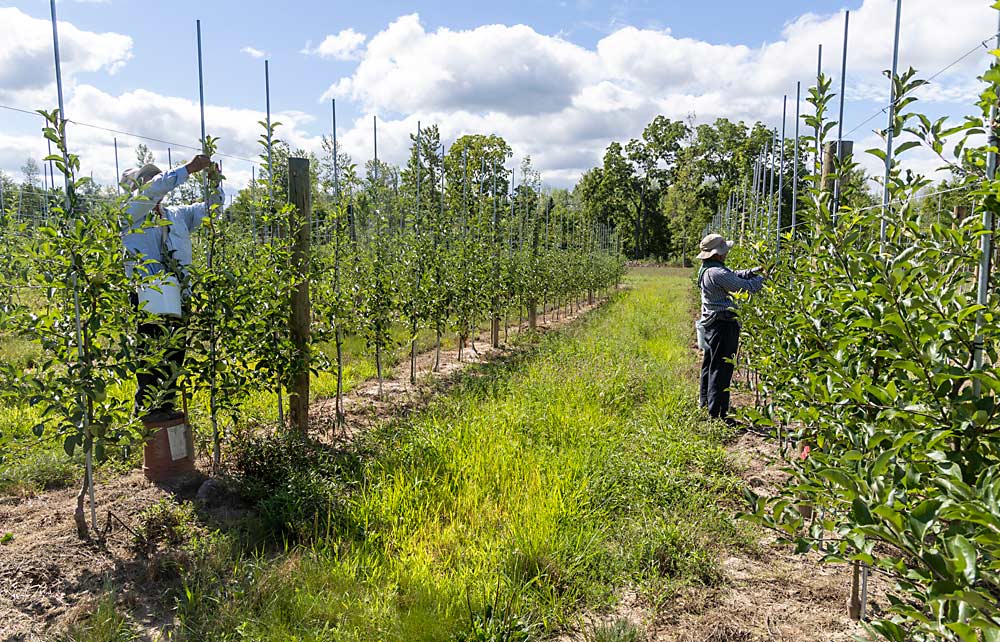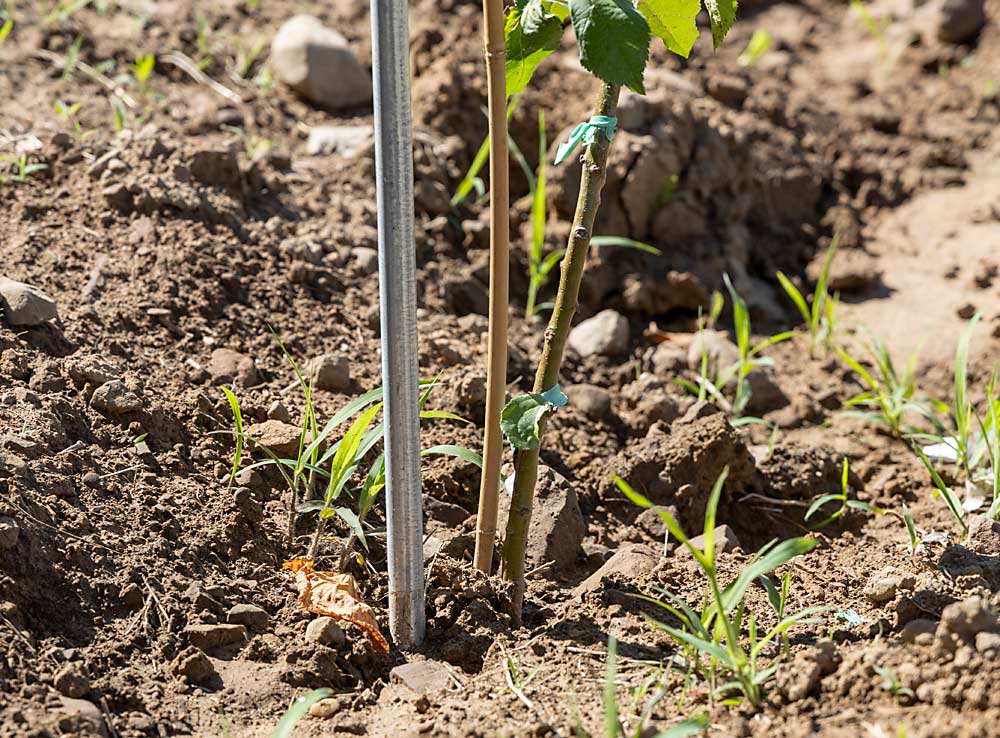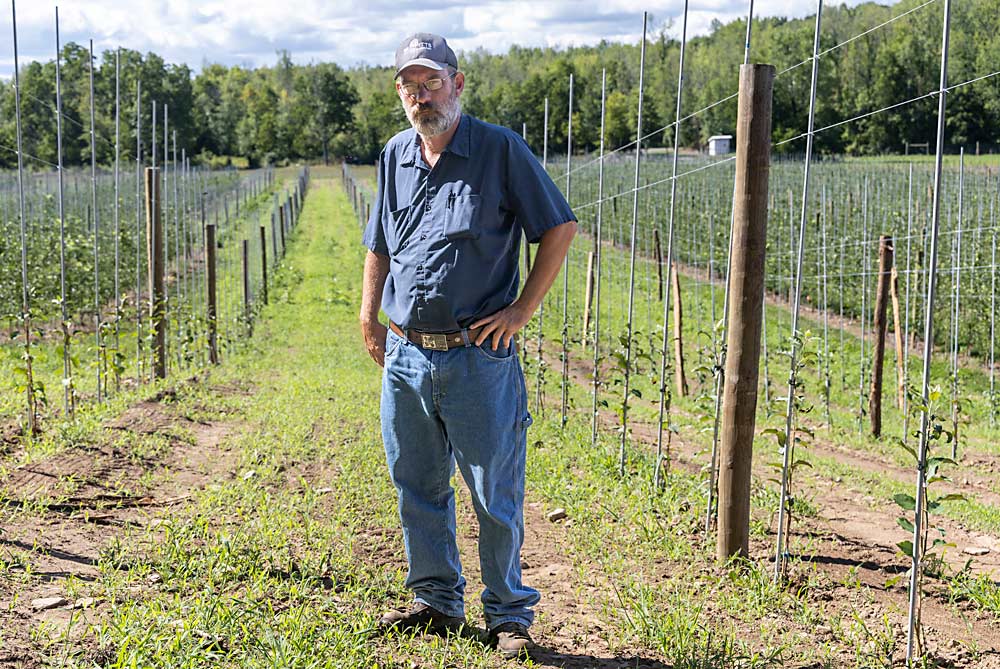
Western New York apple grower Ned Morgan recently did something unusual: plant a high-density block of Golden Delicious and Rome purposely destined for applesauce.
Typically, when growers invest in a new, high-density planting, they are aiming for the fresh market. Growers have never quite seen the point of spending more up front to plant modern processing apple orchards when prices are low and they have older blocks still in the ground.
But processing apples are fetching higher prices these days, to the point where Morgan — who sells about 70 percent of his apples to processors, many to the nearby Mott’s plant that turns them into applesauce — decided a high-density processing block was worth a try.
He might be on the cutting edge of a new trend. With their freestanding blocks growing older, returns on fresh apples generally flat and processing prices on the upswing, growers in states that sell a significant percentage of their apples to processors, such as New York, Michigan and Pennsylvania, are starting to wonder: Could high-density processing plantings actually be profitable?
In New York, growers are still surviving on older processing blocks, many planted with 200 to 250 trees per acre on Malling 111 or Budagovsky 118 rootstock. Those blocks aren’t going to last forever, and planting new blocks on the same rootstocks at the same density will not pencil out, said Cornell University tree fruit physiologist Terence Robinson.
Robinson envisions profitable modern processing blocks planted either on semidwarf Geneva 890 rootstock, spaced 6 feet by 14 feet (519 trees per acre) in a vertical axis system, or trees on dwarf G.969 rootstock spaced 4 feet by 12 feet (908 trees per acre) in a tall spindle system.
Those systems are projected to have higher early yields, higher lifetime yields and improved profitability, compared to typical low-density processing orchards, even though the initial investment is higher. They’ll also be more adaptable to mechanical pruning and harvest, Robinson said.

But growers want more than projections, so Cornell and Mott’s owner, Keurig Dr Pepper (KDP), agreed to plant research blocks comparing Cornell’s high-density production systems with a more traditional processing system. The blocks will be planted in two Western New York commercial orchards in 2023. KDP is providing funding, said Whitney Kakos, director of sustainable supply chains.
The Mott’s plant in Western New York purchases apples from more than 100 surrounding orchards, fruit that’s processed into the vast majority of the brand’s applesauce products. Demand for those products has risen since the coronavirus pandemic started, and KDP wants to make sure its suppliers have the best data available to keep themselves sustainable. The company has done similar long-term research in the coffee industry, Kakos said.
The trials will compare Ida Red, Golden Delicious and Rome trees grown using the vertical axis system on G. 890, the tall spindle system on G. 969 and a more traditional processing system, central leader on B.118, over a 10-year period. Robinson projects that the vertical axis/G.890 system and tall spindle/G.969 system will yield a higher return on investment than the central leader system.
Crucial to the calculations of Robinson’s preferred systems is that the trees are grown using the “grow-through” method — which keeps them in the nursery for at least an extra year, compared to standard nursery-grown trees. Grow-through trees are cheaper than standard trees, have higher early yields and are more profitable in the long run, he said.
But the grow-through method is primarily practiced by New York growers with on-farm nurseries. Growers who are considering Cornell’s high-density processing blocks but do not have on-farm nurseries must weigh the cost of standard nursery trees versus the price received from processors. At 12 cents per pound of apples, a high-density block on standard trees won’t pencil out, but it will pencil out at 16 cents per pound, Robinson said.
Morgan planted his first high-density processing trees in spring 2021 — Golden Delicious on M.9-337, spaced 3 feet by 12 feet. The trees were grown the standard way in his on-farm nursery, but he didn’t have enough to fill the 4-acre block. He filled it the following year with Taylor Rome trees grown in Ellepots on G.969 rootstock, which he purchased from Wafler Nursery. He spaced those at 4 feet by 12 feet, and he picked G.969 based on Robinson’s advice, he said.

“It took a lot of money to get this up and running, but it’s a lot more efficient to maintain,” said Morgan’s orchard manager Ben Nevlezer. “Processing prices fluctuate quite a lot, but with decent prices I think we can definitely make money.”
They’re hoping to average 1,600 to 1,700 bushels per acre when the trees are fully grown, Nevlezer said.
Until recently, Michigan grower Andy Riley focused his new high-density plantings on the fresh market, because that’s where the dollars were. But with processing prices rising from 10 cents per pound not long ago to 20 to 24 cents per pound this year, he’s shifting strategies and now plans to plant high-density processing blocks next spring and the following spring, he said.
Like Western New York, Riley’s region of West-central Michigan has a long tradition of growing processing apples.
“We have close relationships with processors,” he said. “Every year, they’re asking for more processing apples. It’s a total turnaround from several years ago.”
His high-density processing trees will be Jonagold (he’s not yet sure of the rootstock), spaced 3 feet by 11 feet. Jonagold is in high demand from one of his processing buyers, and that spacing works well in his fresh blocks, he said.
Riley’s older processing blocks, planted in the 1990s and 2000s, are spaced 8 feet by 18 feet. He said it will cost about $15,000 per acre to establish high-density processing plantings. That’s more expensive than establishing a traditional processing block, but high-density yields sooner, yields more and is more profitable in the long run, he said.
—by Matt Milkovich






Hello,
it is so interesting issue just, what about the investment costs?
Best golden varity for market as well as for processing